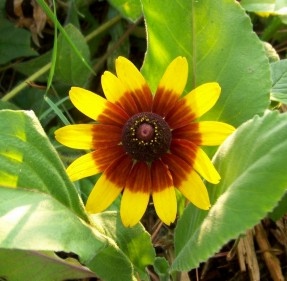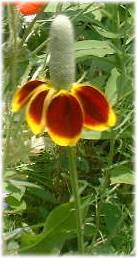|
Gardens Ablaze |
||
|
|
Wildflowers
|
|
|
Detailed Wildflower Profiles Site Map
Home
|
Unfortunately, wildflowers are often overlooked in the home landscape, but this shouldn't be the case. They are versatile plants, are relatively easy to grow. They provide beauty both outside in mass plantings that attract butterflies and wildlife, and inside as cut flowers and in dried flower arrangements. Wildflowers in general are very easy to grow, and many are perennial plants that can give conventional perennials a real run for their money as far as length of bloom time and bright colors. As such, wildflowers can and should be added to perennial borders wherever a tough, reliable plant is needed.
For
those desiring to naturalize an area with wildflowers only, select a site that
This section is devoted to the uses of wildflowers in the landscape and to the individual plant characteristics. Categories of plants often overlap with other areas, but hopefully site navigation is good enough to get you where you want to be quickly and easily. I have included pictures and cultural requirements for every plant researched on this site, and there's more to come soon, so enjoy!
Custom Search
|
|
|
Gardens Ablaze |
||
 Wildflowers
have gained in popularity in recent years, and rightfully so. In the
last 10 years or so, we have seen a real increase in wildflower areas on
roadsides and interstates, reducing the need for expensive mowing and enhancing
the beauty of these otherwise little-used spaces. This is a huge step in
the right direction.
Wildflowers
have gained in popularity in recent years, and rightfully so. In the
last 10 years or so, we have seen a real increase in wildflower areas on
roadsides and interstates, reducing the need for expensive mowing and enhancing
the beauty of these otherwise little-used spaces. This is a huge step in
the right direction.  has
good drainage, and then rid the area of as many weeds as possible.
Mow the area low, and then rake or lightly till the surface to a depth of
about one inch maximum. Tilling too deeply will expose thousands of
new weed seeds and you will be plagued for years to come. Broadcast
half the seed, spreading it before you horizontally back and forth, then
repeat with the other half of the seed while standing perpendicular to the
way you were originally. This will give you good coverage of the area.
Fall or early spring is the best time to plant a new wildflower garden,
unless you are in a very harsh winter climate. If this is the case,
plant as soon as the ground can be worked in the spring. Once the
bed is seeded, walk over it or roll it with a roller to give the seeds good
contact with the soil. You want firm contact, but you don't want the
seed to be planted too deeply. The depth at which the seed is sown
is the most common problem for failure to germinate with wildflower seeds,
so tread lightly when doing the original planting.
has
good drainage, and then rid the area of as many weeds as possible.
Mow the area low, and then rake or lightly till the surface to a depth of
about one inch maximum. Tilling too deeply will expose thousands of
new weed seeds and you will be plagued for years to come. Broadcast
half the seed, spreading it before you horizontally back and forth, then
repeat with the other half of the seed while standing perpendicular to the
way you were originally. This will give you good coverage of the area.
Fall or early spring is the best time to plant a new wildflower garden,
unless you are in a very harsh winter climate. If this is the case,
plant as soon as the ground can be worked in the spring. Once the
bed is seeded, walk over it or roll it with a roller to give the seeds good
contact with the soil. You want firm contact, but you don't want the
seed to be planted too deeply. The depth at which the seed is sown
is the most common problem for failure to germinate with wildflower seeds,
so tread lightly when doing the original planting.